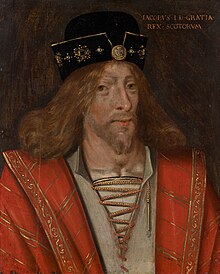
Back Iacobus I Scotta Cyning ANG جيمس الأول ملك إسكتلندا Arabic جيمس الاول ملك اسكتلندا ARZ بیرینجی جیمز (ایسکاتلند) AZB Якаў I (кароль Шатландыі) Byelorussian Джеймс I (Шотландия) Bulgarian Jakez Iañ (Bro-Skos) Breton Jaume I d'Escòcia Catalan Jakub I. Skotský Czech Iago I, brenin yr Alban Welsh
| James I | |
|---|---|
 16th century portrait of James | |
| King of Scots | |
| Reign | 4 April 1406 – 21 February 1437 |
| Coronation | 21 May 1424 |
| Predecessor | Robert III |
| Successor | James II |
| Regents | See list
|
| Born | possibly 25 July 1394[1][2] Dunfermline Abbey, Fife, Scotland |
| Died | 21 February 1437 (aged 42)[3][4] Blackfriars, Perth, Scotland |
| Burial | |
| Spouse | |
| Issue | |
| House | Stewart |
| Father | Robert III of Scotland |
| Mother | Annabella Drummond |
Events
| |
James I (late July 1394 – 21 February 1437) was King of Scots from 1406 until his assassination in 1437. The youngest of three sons, he was born in Dunfermline Abbey to King Robert III and Annabella Drummond. His older brother David, Duke of Rothesay, died under suspicious circumstances during detention by their uncle, Robert, Duke of Albany. James's other brother, Robert, died young. Fears surrounding James's safety grew through the winter of 1405–1406 and plans were made to send him to France. In February 1406, James was forced to take refuge in the castle of the Bass Rock in the Firth of Forth after his escort was attacked by supporters of Archibald, 4th Earl of Douglas. He remained at the castle until mid-March when he boarded a vessel bound for France. On 22 March, an English vessel captured the ship and delivered the prince to Henry IV of England. The ailing Robert III died on 4 April and the 11-year-old James, now the uncrowned King of Scots, would not regain his freedom for another eighteen years.
James was educated well during his imprisonment in England, where he was often kept in the Tower of London, Windsor Castle, and other English castles. He seems to have been generally well treated, and he developed a respect for English methods of governance.[17] James joined Henry V of England in his military campaigns in France between 1420 and 1421. His cousin, Murdoch Stewart, Albany's son, who had been an English prisoner since 1402, was traded for Henry Percy, 2nd Earl of Northumberland, in 1416. However, Albany refused to negotiate for James's release. James married Joan Beaufort, daughter of the Earl of Somerset, in February 1424. This was just before his release in April. The king's take back into Scottish affairs was not altogether popular, since he had fought on behalf of Henry V in France and at times against Scottish forces. Noble families now faced increased taxes to cover the ransom payments, and would also have to provide family hostages as security. James, who excelled in sports such as wrestling and tennis, literature, and music, also strongly desired to impose law and order on his subjects. Sometimes he applied such order selectively.
To secure his position in the Scottish court, James launched pre-emptive attacks on some of his nobles beginning in 1425 with his close kinsmen, the Albany Stewarts. This resulted in the execution of Duke Murdoch and his sons. In 1427 James called all the Highland clans to a parliament in Inverness. They came in great numbers. There, James treacherously murdered some and imprisoned others, effectively destroying any peace he might have had with them. He was said to be amused at the success of his plot.[18] One of those imprisoned at Inverness was Alexander, Lord of the Isles, along with his mother, Mariota, Countess of Ross, who James kept prisoner on the island of Inchcolm in the Firth of Forth. Because of his betrayal, James was never again trusted by those in the Isles and the North.
Archibald, 5th Earl of Douglas, was arrested in 1431, followed by George, Earl of March, in 1434. The fate of Scottish prisoners in England was ignored by Scotland's ruling elite and the repayment money was diverted into the construction of Linlithgow Palace and other schemes. In August 1436, James's siege of Roxburgh Castle failed, and he subsequently faced an ineffective attempt by Sir Robert Graham to arrest him at a general council. James was assassinated at Perth on the night of 20/21 February 1437 during a failed coup by his uncle Walter Stewart, Earl of Atholl. Queen Joan, although wounded, managed to evade the attackers and reached her son — now King James II — in Edinburgh Castle.
- ^ a b Weir, Britain's Royal Families, p. 232
- ^ Cite error: The named reference
Brown, p 9was invoked but never defined (see the help page). - ^ Weir, Britain's Royal Families, p. 235
- ^ Brown, James I, pp. 186–187
- ^ Boardman, Early Stewart Kings, p. 291
- ^ Brown, James I, p. 17
- ^ Nicholson, Scotland: The Later Middle Ages, pp. 278–279
- ^ Weir, Britain's Royal Families, p. 130
- ^ Brown, James I, p. 19
- ^ Stevenson, Chivalry and knighthood in Scotland, 1424–1513 p. 170
- ^ Brown, James I, p. 28
- ^ Nicholson, Scotland: The Later Middle Ages, p. 287
- ^ Nicholson, Scotland: The Later Middle Ages, pp. 293–295
- ^ Grant,Independence and Nationhood, p. 188
- ^ Grant,Independence and Nationhood, pp. 189–190
- ^ McGladdery, The Kings & Queens of Scotland: James I, p. 143
- ^ Brown, Michael (1994). James I. Edinburgh, Scotland: Canongate Academic. pp. 17–20.
- ^ Donald J. Macdonald, Clan Donald, 1978, p. 93.
© MMXXIII Rich X Search. We shall prevail. All rights reserved. Rich X Search